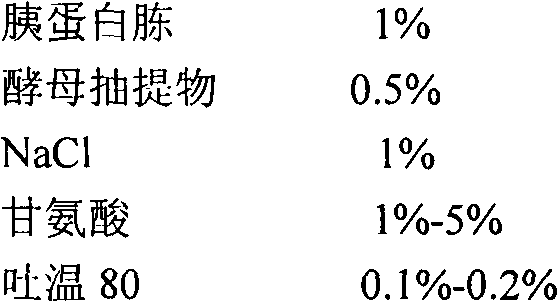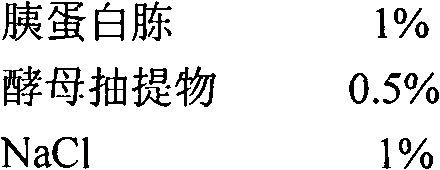Electrotransformation method for introducing shuttle plasmid into corynebacterium acetoacidophilum
A technology of shuttle plasmid and coryneform bacteria, which is applied in the field of high-efficiency electrotransformation of introducing recombinant shuttle plasmid into Corynebacterium acetic acidophilus, and achieves the effects of stable transmission, improving transformation efficiency and reducing hindering effect.
- Summary
- Abstract
- Description
- Claims
- Application Information
AI Technical Summary
Problems solved by technology
Method used
Image
Examples
specific Embodiment approach
[0023] 1. The plasmid vector pK19mobsacB selected by the present invention (Schafer A, Tauch A, Jager W, et al. Small mobilizable multi-purpose cloning vectors derived from the Escherichia coli plasmids pK18 and pK19: selection of defined deletions in the chromosome of Corynebacterium glutamicum. Gene, 1994, 145(1): 69-73) contains foreign genes, which can be replicated in Escherichia coli and can be integrated into the genome of Corynebacterium acetophilus. Due to the compact and thick peptidoglycan layer of the cell wall of Corynebacterium acetophilus, and the complex structure of the cell surface, it is impossible to introduce foreign DNA through the preparation of a competent state, and it is also affected by the restriction endonuclease that recognizes the methyl group of Corynebacterium acetophilus itself and other Restriction enzymes recognize and destroy recombinant plasmids, making it difficult to obtain recombinant bacteria.
[0024] The present invention amplifies r...
Embodiment 1
[0034]Inoculate the fresh Corynebacterium acetophilus ATCC13870 preserved on the slant into 5ml LBG medium, and inoculate it with 1% inoculum amount to a medium containing 3% glycine, 0.1% Tween 80, 1% tryptone, and 0.5% yeast extract. extract in 1% NaCl medium. Cultivate at 30°C and 220 rpm until the OD600 of the cells reaches 0.4, add ampicillin to a final concentration of 1 μg / ml, and continue to cultivate for 60 minutes. 4000g, 10min centrifugation to recover the bacterial cells, after preparing competent cells, put the competent cells on ice to thaw, add 5 μl unmethylated recombinant plasmid pK19mobsacB containing exogenous gene, 10 μl electric shock buffer and mix well, after electric shock 46 Heat shock at ℃ for 6 minutes, spread all the samples on LB solid medium with 25 μg / ml kanamycin, and culture in an oven at 30℃ for 36-48 hours, and then a single colony can grow. The conversion rate reaches 5.2×10 4 cfu / μg DNA, exogenous plasmids can be efficiently introduced in...
Embodiment 2
[0036] Inoculate the fresh Corynebacterium acetophilus ATCC13870 preserved on the slant into 5ml LBG medium, and inoculate it with 1% inoculum amount to a medium containing 2% glycine, 0.15% Tween 80, 1% tryptone, and 0.5% yeast extract. extract in 1% NaCl medium. After culturing at 30° C. and 220 rpm until the OD600 of the cells reached 0.6, ampicillin was added to a final concentration of 1 μg / ml, and the culture was continued for 90 minutes. 4000g, 10min centrifugation to recover the bacterial cells, after preparing competent cells, put the competent cells on ice to thaw, add 5 μl unmethylated recombinant plasmid pK19mobsacB containing exogenous gene, 10 μl electric shock buffer and mix well, after electric shock 46 Heat shock at ℃ for 6 minutes, spread all the samples on LB solid medium with 25 μg / ml kanamycin, and culture in an oven at 30℃ for 36-48 hours, and then a single colony can grow. The conversion rate is as high as 6.4×10 4 cfu / μg DNA.
PUM
 Login to View More
Login to View More Abstract
Description
Claims
Application Information
 Login to View More
Login to View More - R&D
- Intellectual Property
- Life Sciences
- Materials
- Tech Scout
- Unparalleled Data Quality
- Higher Quality Content
- 60% Fewer Hallucinations
Browse by: Latest US Patents, China's latest patents, Technical Efficacy Thesaurus, Application Domain, Technology Topic, Popular Technical Reports.
© 2025 PatSnap. All rights reserved.Legal|Privacy policy|Modern Slavery Act Transparency Statement|Sitemap|About US| Contact US: help@patsnap.com



